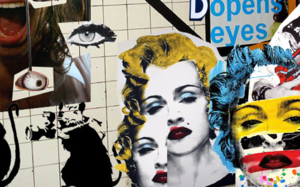| 85288 | nmac 4460.01 | Online | Fall, 2019 |
Remix & Participatory Culture
September 23–September 27
Goals:
|

Lesson five examines what Lawrence Lessig calls “remix culture” and what Henry Jenkins calls “participatory culture”: using digital tools to have a voice in the cultural texts that shape our lives. While intellectual property laws criminalize would-be artists who appropriate professional culture, a new generation of digital artists work in the margins of between sanction and freedom. Copyright was written for an analog world, but when digital copies are perfect and easily distributed, why hasn’t law and caught up? We seem no longer content to leave culture to the professionals or the experts. The hacker sensibility combined with a digital literacy has precipitated a new amateur culture that practices expression for the love, not the cash.
Should we have a face-to-face session? Take the poll. |
Wikipedia Project Considerations
Over the past few weeks, you have become more familiar with the workings of Wikipedia and seen articles for several of the texts and thinkers in new media. This week, I ask you to have a look at the available articles on the WikiEdu dashboard and start to think about which you might want to work on as your semester project . You needn’t decide right now, but you should begin to get an idea during this lesson.
Notice that there are basically two types of articles: thinkers and texts. I have tried to include all available articles in need of editing. You will want to choose something that you’re interested in doing more research on — equivalent to a research paper. You might even start a preliminary annotated bibliography in your Wikipedia sandbox.[1]
Next, find something about editing or contributing to Wikipedia that you did not know and try it out in your next journal post.
Remix
Watch Lessig’s “Laws that Strangle Creativity”[2] and Jenkins’ “Participatory Culture.”[3] Each of these TED talks give a pretty solid overview of what each covers in his longer study: Remix and Convergence Culture, respectively. It’s worth your time to read, at least, the introduction to Convergence Culture and the introduction and part 1 of Remix.
Journal Post 9
Resources to review for journal posts: “Writing in the Liberal Arts”; “Writing Top Ten”; “Editor’s Checklist”; Adding a reference. Cite sources correctly using footnoted references, and link to Wikipedia entries in the text of your post.[4] |
Consider one of the following in writing your post:
- What have you learned about “culture” and the issues digital media bring to our understanding and practice of it?
- What is “amateur culture,” both before the digital age and since?
- What is “professional culture” and how did it develop?
- Lessig points out a conflict raging between technology and law. What are the implications of this war?
- Why is it important in a digital age to make artistic productions easily available?
- What is BitTorrent, and what is the largest site for torrents on the Internet?
- Once it’s released, who owns culture?
- What does Lessig mean by “remix” and why is it “an essential act of RW creativity”?
- Lessig argues that we must protect RO culture, but not at the expense of RW.[5] What does he mean, and how does he propose to do it?
- What does the music community in general think of current copyright laws and “illegal” downloading? What about other artists?
- What defines “convergence culture” and/or “participatory culture”? How does it relate to Lessig’s concerns?
Explore
Look at a couple of the texts on the suggested readings or find your own that address some of the issues that concern Lessig and Jenkins. Where are we currently in our relationship with the owners of IP?
Journal Post 10
What more did you learn about participatory and remix culture? How does that fit into your understanding of new media? Try to bring in several different sources to support your ideas.
Reply to at east one of your colleagues’ journal posts for this lesson.
Due Date
Please have all of the above completed by Sunday, September 29, 2019. I will evaluate your this lesson the following day, email everyone a progress report, and post audio feedback at the top of the next lesson if necessary.
Help is always available:
|
Notes
- ↑ Just click “Sandbox” in the upper-right of the Wikipedia widow when you are logged in. There is no correct or incorrect way to do this, but a strong approach is to list a source using the correct Wikipedia citation template, then give a brief synopsis of the source. You might see this critical bibliography for an example.
- ↑ You might also have a look at his “Re-examining the Remix.”
- ↑ You might have a look, too, at “Henry Jenkins on Participatory Culture.”
- ↑ External sources are always footnoted as references; Wikipedia entries are always just linked in the text. Never cite a Wikipedia article like you would an external source.
- ↑ Lessig, Lawrence (2008). Remix: Making Art and Commerce Thrive in the Hybrid Economy. New York: Penguin. p. 90.
